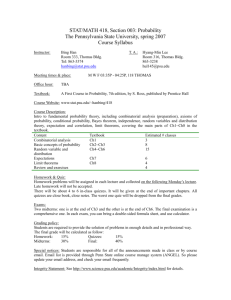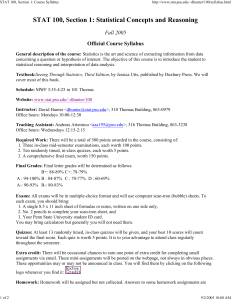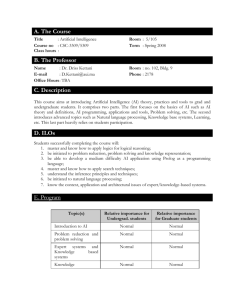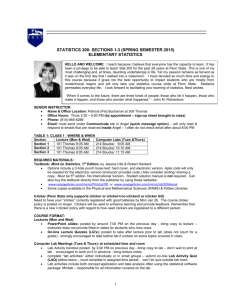Syllabus: Stat 200 Elementary Statistics (Fall 2003)
advertisement
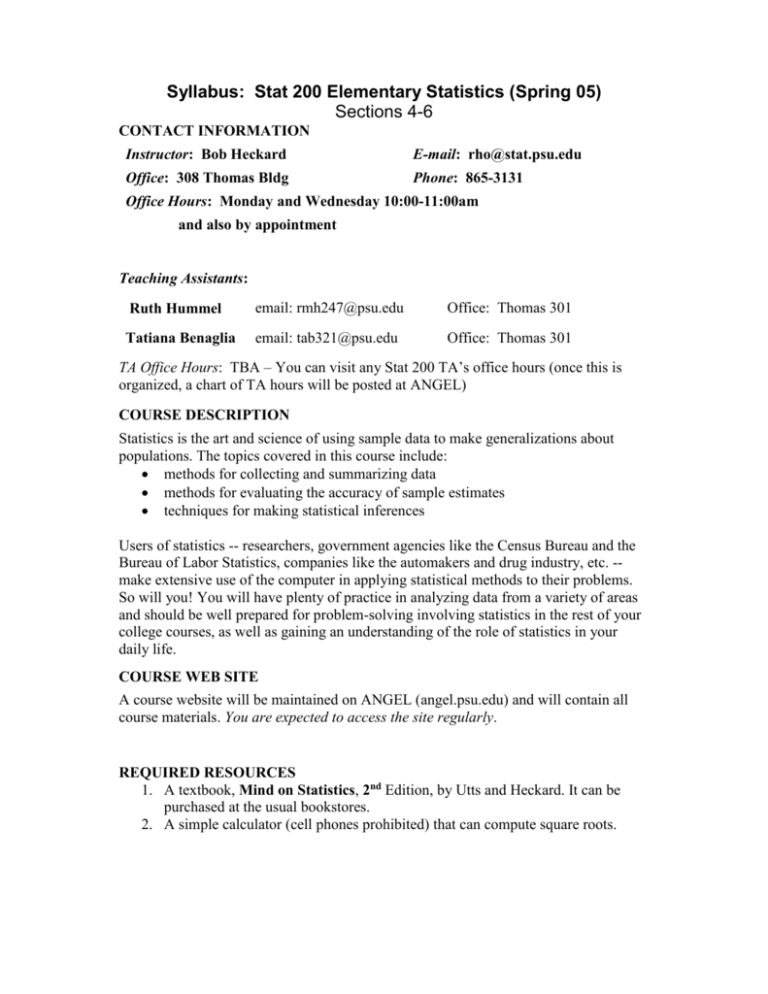
Syllabus: Stat 200 Elementary Statistics (Spring 05) Sections 4-6 CONTACT INFORMATION Instructor: Bob Heckard E-mail: rho@stat.psu.edu Office: 308 Thomas Bldg Phone: 865-3131 Office Hours: Monday and Wednesday 10:00-11:00am and also by appointment Teaching Assistants: Ruth Hummel email: rmh247@psu.edu Office: Thomas 301 Tatiana Benaglia email: tab321@psu.edu Office: Thomas 301 TA Office Hours: TBA – You can visit any Stat 200 TA’s office hours (once this is organized, a chart of TA hours will be posted at ANGEL) COURSE DESCRIPTION Statistics is the art and science of using sample data to make generalizations about populations. The topics covered in this course include: methods for collecting and summarizing data methods for evaluating the accuracy of sample estimates techniques for making statistical inferences Users of statistics -- researchers, government agencies like the Census Bureau and the Bureau of Labor Statistics, companies like the automakers and drug industry, etc. -make extensive use of the computer in applying statistical methods to their problems. So will you! You will have plenty of practice in analyzing data from a variety of areas and should be well prepared for problem-solving involving statistics in the rest of your college courses, as well as gaining an understanding of the role of statistics in your daily life. COURSE WEB SITE A course website will be maintained on ANGEL (angel.psu.edu) and will contain all course materials. You are expected to access the site regularly. REQUIRED RESOURCES 1. A textbook, Mind on Statistics, 2nd Edition, by Utts and Heckard. It can be purchased at the usual bookstores. 2. A simple calculator (cell phones prohibited) that can compute square roots. COURSE FORMAT Lectures will be given Mondays, 1:25-2:10 in 101 Thomas. The lectures will give an overview of the material that will be implemented in the Tuesday, Thursday labs, and will include problem-solving help. In the Tuesday and Thursday section meetings you usually will work in groups to do activities that that will help you master the reading and lecture material for that week. Quizzes and exams will also be administered during the Tuesday/Thursday section meetings. EXTRA HELP Three hours of tutorial help will be held weekly (TBA) by Stat 200 TAs to provide assistance to you in understanding concepts, to help you with homework, and to help you with prepare for exams and quizzes. These tutorials are in addition to the normal office hours. As soon as in is available, a schedule will be posted to the ANGEL website SUMMARY OF COURSE REQUIREMENTS What? When/How often? 1. Quizzes 5 quizzes, lowest score dropped Quiz dates given below March 1-March 4 End of April Most weeks (12 given, highest 10 scores count) Feb 24 Apr 14 During Finals, Date TBA Total 2. Group Project 1 Group Project 2 3. Homework and Lab activities 4. Midterm Exam 1 Midterm Exam 2 Final Exam Points Percent 200 20% 80 120 200 8% 12% 20% 100 100 200 1000 10% 10% 20% 100% SOME DETAILS ABOUT COURSE REQUIREMENTS 1. Quizzes. Likely dates are Jan 27, Feb 10, Mar 17, Mar 31, and Apr 28. The quizzes, which will have15 multiple-choice questions, will be conducted as follows: INDIVIDUAL PART: Each student will first take the quiz as an individual. About 15 minutes will be allowed, and then students will turn in answers. GROUP PART: Students will work in groups (3 to 5 per group) to answer the same questions (immediately after the individual part). Each student will submit a second set of answers based on group discussions. It is possible to disagree with your group and put down a different answer that you think is correct! SCORE: Overall Percent = (2*INDIVIDUAL+GROUP)/3 RULES: Lowest overall quiz score of the 5 will be dropped. Missed quizzes cannot be made up. Early quizzes may be given to those required to miss class due to official University activities. 2. Group Projects Some section meetings in the course will be devoted to group project work involving the integration of course content, such as analyzing and interpreting survey data, and interpreting the results of research reports. For each of the two projects, one report will be submitted per group. RULES: Late group projects will be penalized. Students not able to participate with a group due to illness or official University activities must still do the project as an individual, and in those instances a make-up grace period will be given. 3. Homework and Lab Activities It is anticipated that there will be 12 homework assignments to be handed in during the semester. Homework will consist of lab activities and also some exercises from the textbook. Each homework/lab activity will be graded on a 20-point basis. The ten highest scores will count and lowest two will be dropped. RULES: Homework over one week late is not accepted. Homework within one week late will be penalized such that the highest score available is a 10 instead of a 20. 4. Midterm Exams and Final Two midterms, and one final exam will be given. The exams will have multiple-choice and sections. The first midterm is tentatively set for February 24th and the second on April 14th. The final exam will be scheduled by the university or will be the last day of classes. Study guides and in-class review will be provided for all exams. RULES: Make-ups will be given, but reasons for missing an exam must be documented, and you must tell me by e-mail on or before the day of the exam that you will need a make-up. The final exam can be rescheduled through the University only if a conflict is present. Academic Integrity Academic integrity, which is the pursuit of scholarly activity free from fraud and deception, is an educational expectation at Penn State. This course will follow the guidelines found in Section 49-20 of the University Faculty Senate Policies for Students. See http://www.science.psu.edu/academic/Integrity concerning academic integrity for details. COURSE GOALS At the end of this course, you should be able to: 1. Understand the reasoning by which findings from sample data can be extended to larger, more general populations. 2. Critically evaluate the results of scientific studies. 3. Design, conduct, and analyze a scientific research study. 4. Read statistical summaries. 5. Analyze data using statistical software (Minitab). 6. Study and understand examples and applications from a variety of fields. 7. Learn independently and work cooperatively. COURSE RULES 1. SEE RULES GIVEN UNDER THE DESCRIPTIONS OF EACH CATEGORY OF COURSE REQUIREMENTS. 2. Students are responsible for all announcements and supplements given within any lecture or lab, as well as those not announced but posted on the course website calendar. 3. Cheating will be punished in accordance with University guidelines. COURSE GRADES You will be graded based on the total score obtained from all of your course work. Course grades in each of the nine categories will be awarded based on the following bounds: Final Grade A AB+ B BC+ C D F below Points 930 900 870 830 800 770 700 600 600 Percent 93 90 87 83 80 77 70 60 below 60 The lower bounds may be lowered if the course work is judged to be different than in previous semesters. This judgment will be made in consultation with the other Stat 200 instructors after all of the course work is graded. (Usually, there is only a small change to these borderlines!) IMPORTANT COURSE ADMINISTRATION DATES Please note that as a student registered for this course, you are responsible for taking care of certain administrative details before the following university-wide deadlines: Final Exam Conflict - Filing Period February 7-20 Spring Break – No Classes March 7-11 Late Drop Deadline April 8 Classes End April 29 Final Exams May 2-6 Statistics 200, Pennsylvania State University, University Park Campus Course Coverage 1. Descriptive Statistics for Categorical Variables Frequency and relative frequency distributions, two-way tables, graphical displays 2. Descriptive Statistics for One Quantitative Variable Histograms, boxplots, stemplots, mean, median, standard deviation, variance, 5-number summaries 3. Descriptive Statistics for Two Quantitative Variables Scatterplots, simple regression, correlation 4. Probability and Probability Distributions Basic probability definitions, discrete and continuous random variables, binomial distribution, normal distribution 5. Sampling Distributions Statistics, parameters, concept of a sampling distribution, sampling distribution of a sample mean, sampling distribution of sample proportion, Central Limit Theorem 6. Confidence Intervals Interpretation and purpose of confidence interval and confidence level, confidence intervals for a proportion, for a mean or for mean difference with paired data, for difference in two means, for difference in two proportions 7. Hypothesis Tests Null and alternative hypotheses, p-values, type 1 and 2 errors, statistical power, effect of sample size on significance, rejection regions. Hypothesis tests about a proportion, about a mean or mean difference with paired data (t-test and paired t-test), about difference in two means (two-sample t-test), hypothesis test about difference in two proportions 8. Inference for Regression and Correlation Hypothesis tests for slope of straight line and for correlation, prediction intervals. 9. Inference for Two-Way Tables Chi-square test for two-way tables 10. One-Way Analysis of Variance F-test for comparing several means 11. Methods for Collecting Data in Sample Surveys and Experiments Simple random sampling, stratified sampling, cluster sampling, systematic sampling, random digit dialing, randomization, matched pairs, blocking, confounding issues

